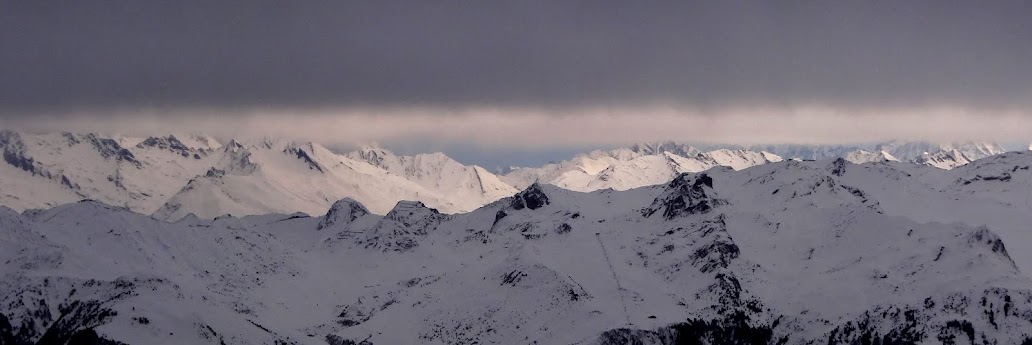Mark and Claire are two very different skiers but the contrast actually makes it useful for them to be coached together. Mark needs to be obliged to slow down to be able to have any chance of overcoming his recurring habits and he needs to learn the missing fundamentals in his skiing by working on exactly the same exercises as Claire. Claire had consolidated the work from her previous session and was fairly confident with dynamics. Similar to Christine the day before she was only able to follow the skis and had no upper/lower body separation or angulation so this would have to be the next lesson. Although I specifically wanted Mark to be better centred on his skis this would be useful towards this objective too.
I repeated the same static exercise for angulation as documented in yesterday’s blog. In fact everything about Angulation, Upper/Lower Body Separation, Pole Planting and Chi Skiing were the same – including the Chi Walking at the end - so the full details can be found here: http://www.skiinstruction.blogspot.fr/2014/01/brian-christine-2.html in yesterday’s post.
Even the “Mr Vertical” lesson yesterday for Brian was repeated for Mark today as both skiers seem to have cultivated the same underlying problems together.
Foot Forwards
Claire hadn’t previously learned to push the foot forwards and had not yet mastered pivoting so those elements would need to be developed in order to cultivate angulation and upper/lower body separation. Claire wasn’t sure at first if she was pushing the ski forwards but her turns were immediately tighter. Both mark and Claire were surprised to learn that this is the principle tool for controlling turn radius. On steeper terrain you have to use greater dynamics and a stronger, rapid push forwards of the outside foot. Mark was also able to tighten his turns. The ski lifts us up by cutting in front of our trajectory and pushing it forwards makes this process more active – hence tightening the turn radius. The foot never actually gets ahead very much – the turn just tightens instead.
Pivoting
To help Claire develop some confidence in pivoting I helped her to feel the pivot by assisting her physically through some turns – statically and also skiing with her holding onto a pole. I explained the braking nature of the pivot as opposed to the accelerating nature of the stem or plough and how although apparently more difficult initially it was in reality much easier. The stem is an emotional response to seek security by pushing the ski outwards and partially turning it. This however puts the ski on an edge pointing downhill and making it into an accelerator. The pivot is the clever way to circumvent this emotional response – with the skis always on a braking uphill edge and only pointing freely downhill momentarily when flat.
Side-slipping exercises were used for a while to help Claire develop some confidence about travelling sideways for pivoting. Both Mark and Claire had trouble initially keeping the lower hip tucked in and the bottom turned to face uphill (hip angulation). I explained and demonstrated that the feet could roll outwards to allow the skis to flatten the and knees could also – but the hip must stay tucked in so that angulation and control over the body remains.
Mark did a good job of pivoting on one ski (both directions) – using his pole very effectively for support.
Short Swings
Short swings are a great way to develop coordination, rhythm, timing and efficiency. The jump has to be mainly from the lower leg and it is really a pivot with the start carried out with the skis in the air. There are many variations of the short swing but the standard one involves a clean jump with the legs straightening and then legs bending on landing to soften the impact. The skis only have to swing about 20° in the air and then the pivot continued on the snow. The body has to be projected between the ski tips and the pole so this was an ideal exercise for mark to improve his centring over his skis. Mark was initially so far back when jumping that the pivot point of his skis was somewhere near the rear – making it very difficult. Once this was pointed out he was able to get the pivot point under his feet – near the centre of the skis where it should be.
Vision
When the light began to fade so did Claire’s skiing as she slowed down more and more. When she was skiing behind me I noticed that she was looking at the ground and that’s when I realised why she was skiing slowly in general and getting frustrated by this. Staring at the ground makes the ground seem to rush at you – like looking at the ground out of a train window. This forces you to slow down to cope. Claire added that she was looking at this narrow area also so as to not see the large intimidating slope. All this of course was having an effect the opposite of the one she hoped for. I asked her to trust her peripheral vision and her other senses and to raise her eye-line and look at me as I skied in front. This freed her up from the paralysing problem of ground rush. Similar techniques have to be used when skiing in a white-out, especially off-piste. You have to completely avoid staring into the cloud and focus on feelings through the feet, good appropriate protective stance and posture, dynamics and relaxation.
Centred
Both Mark and Brian have to work hard to be more consistently centred over the skis – this being their main technical issue by far. Some carving sessions on very short Snowblades might help with this.



No comments:
Post a Comment